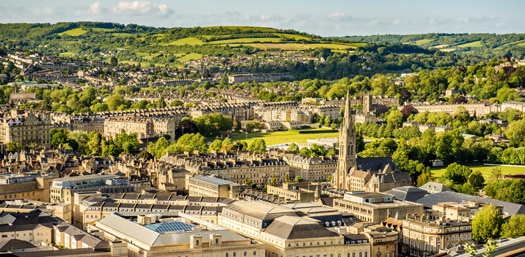Property Investment and Buy-to-Let in the South West
The south-west is England’s largest region and the most sparsely populated, with a reputation for clotted cream and Cornish pasties. So can it even offer any opportunities for property investors at all? In this report we’ll look at some of the best areas of the south-west property investors ought to take a closer look at.
Why Invest in the South West?
The southwest might be known for agriculture and tourism... but that’s only true of the south of the region. According to the European Commission, the north and east parts of the southwest is an economic powerhouse – great news for property investors.
Key industries in these parts of the southwest include high technology manufacturing – in aerospace, defence and electronics – and knowledge-based industries like digital media, semiconductor design and financial services. The report says that the southwest region is home to clusters of industrial and research and development (R&D) activity in aerospace, high-value engineering, microelectronics, new energy systems and digital industries.
This report from PwC’s UK Economic Outlook says the southwest economy is expected to outperform weak UK growth this year. The Good Growth for Cities Index by Demos-PwC ranks Bristol as one of the top ten cities in the entire UK for growth.
Going back to tourism, the southwest is one of the UK’s busiest tourist regions. Visit Britain figures say the area receives 19.1 million overnight tourist trips a year, and tourists spend £4.3 billion – that’s more visitors spending more money than any other region. Devon, Cornwall and Dorset are well-known holiday property spots but property investors might also like to look at Airbnb-type short terms lets in cities like Bristol and Bath.
The southwest also offers opportunities for student property investors. Bristol is a huge university city with around 50,000 students at the University of Bristol and the University of the West of England (UWE). There are also universities at Bath, Bournemouth, Exeter and Plymouth which all have their own student property markets.
Property Values in the South West
Property prices in southwest England are slightly above the national average. According to HM Land Registry statistics, the average house in the southwest currently costs £258,372, just above the national average of around £249,000.
However, there is still cheap investment property available in the southwest for investors who do their homework. Zoopla and Rightmove show prices as low as £50,000 in some places.
This report quoting Savills suggests property investors who consider the southwest could return a tidy profit over the next few years. It says south-west property prices could rise 13.1% over the next five years compared to just 4% in London.
Rental Demand in the South West
Rent rises aren’t usually good news for tenants, but they are welcome news for landlords. They not only mean more income each month but they also usually mean demand for buy to let is strong too. According to one report, rent rises in the south-west of England were faster than anywhere else in England and Wales during a period last year. They say rents rose 4% and that landlords earned an average of £703 a month from each property.
While London remains subdued buy-to-let in the southwest is booming. While the northeast is good for yields the southwest could be a better all-around investment for property investors.
Higher than average property prices mean yields can be tight in some parts of the southwest. Totally Money figures suggest they are in the region of 3% to 6%, although much more should be possible from a student let or holiday let.
This report in The Telegraph says that the very best rental yields in the southwest are to be had along the coast.
A selection of articles on the buy-to-let property investment market in the South West
Investment in the South West
Here’s our guide to property investment in some of the key towns and cities of the south-west of England.
Bristol
Population: 459,300
Average House Price: £291,708
Bristol is thought of as the gateway to the south-west. It’s already the region’s biggest city by far and it’s growing fast – local authority estimates say Bristol’s population will reach over half a million by 2027.
Really good news for property investors is that Bristol is a hotspot for jobs – this report says Bristol is becoming one of the best cities in Europe for jobs growth. Originally a port and trading city Bristol’s newest industries are ones that offer well-paid jobs like financial services, IT, creative and media, digital and tech.
Bristol isn’t all about work though. It is regarded as one of the best places to live and work outside London thanks to its quality of life and offers great shopping, bars, restaurants, clubs, and a music, arts and cultural scene.
Bristol’s popularity means that it is one of the most expensive parts of the south-west for property investors and yields for landlords in Bristol is around 3% to 5% on average.
Would-be investors here might like to look at up-and-coming areas of Bristol. Here’s more information on The Best Areas of Bristol To Invest in Buy-to-Let.
Bath
Population: 176,000
Average House Price: £336,727 (Bath and North East Somerset area)
The Roman City of Bath is a UNESCO World Heritage Site and famous worldwide for places such as the Roman Baths, the Royal Crescent, the Assembly Rooms, Bath Abbey and for its connections with famous novelist Jane Austen.
Bath is also a working city with industries including software, publishing and services and it is also home to the University of Bath and Bath Spa University. However, as average property prices are high here property investors looking at Bath might like to consider high yielding investments like holiday property investments or short term Airbnb type lets.

Bournemouth
Population: 194,000
Average House Price: £250,101
Bournemouth, and the adjacent towns of Christchurch and Poole, make up what is known as the South Dorset conurbation. Although having a reputation as a tourist resort (Bournemouth receives 4.7 million visits annually) and retirement town Bournemouth is a busy business town too.
Bournemouth has a successful economy with key industries here including health, education and the public sector, financial services and a growing digital and tech. sector. More good news for Bournemouth is Dorset Local Enterprise Partnership’s ambition to double the size of the area’s economy and create 80,000 new jobs.
As well as Bournemouth University with 16,000 students Bournemouth is also one of the UK’s most popular locations for private English language courses. It hosts thousands of students who want to learn English annually.

Exeter
Population: 130,000
Average House Price: £261,808
The one-time small rural town of Exeter in Devon is now a fast-growing city. Exeter’s current population is around 130,000 and forecasts say another 25,000 people could be living here in the next decade. In fact, according to EY’s UK Regional, Economic Forecast Exeter is set to be one of the UK’s fastest growing cities over the next three years.
Exeter’s economy is based around services, health, education and new, emerging knowledge-based industries that offer well-paid jobs including research and development and tech. Exeter is a major tech-hub providing 10,000 tech jobs. Exeter overall has the sixth-highest employment level in the country.
Exeter offers the benefits of city living with easy access to Dartmoor and the coast. It is also gaining a reputation for its quality of life and as a vibrant, fashionable place to live and work.
Yields in Exeter itself are typically around 3% to 4%. House prices here have risen sharply in recent years, so property investors might need to seek out up-and-coming areas of Exeter. Here’s more information on The Best Areas of Exeter To Invest in Buy-to-Let.
Plymouth
Population: 234,900
Average House Price: £176,211
Plymouth in Devon, also known as Britain’s Ocean City, has a population of 264,000. Plymouth’s economy is based around maritime industries, and it is also a base for the Royal Navy and Royal Marines. Devonport Royal Dockyard Limited/Babcock International and Princess Yachts are the area’s largest employers.
Plymouth city centre has benefitted from lots of regeneration in recent years and more are planned, with more retail and leisure space, office space, student accommodation for students at the University of Plymouth and hotels to help grow the local tourist trade.
Plymouth is still something of a cheap property hotspot with the lowest property prices of any south-west city.
Here, is an article we produced about the best areas of Plymouth to invest in buy-to-let.
Torquay
Population: 65,200
Average House Price: £201,893
Torquay, together with Paignton and Brixham, makes up the Torbay area of Devon. It’s a popular holiday, tourist and retirement property spot. It has also become popular with some Exeter commuters in recent years as it is generally much cheaper than Exeter. Torquay itself is popular with investors for good-value buy to lets, house shares and HMO investments.
Competitive property prices here mean attractive yields are possible for investors. Torbay Property News says yield of between 4.13% and 9.27% are possible across the area.
About Our Data
Note: Population estimates are based on information provided by Localstats. Current average asking prices are taken from HM Land Registry data and Zoopla. Buy to let yields by postcode are taken from Totally Money Buy-to-Let Rental Yield Map 2019/2020.
